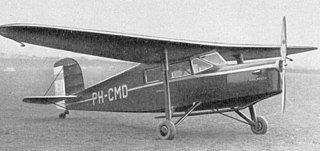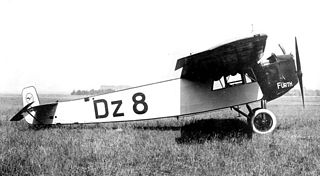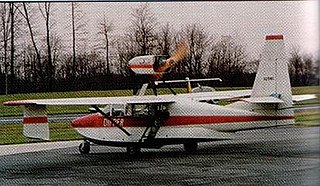
Koolhoven F.K.52 was a Dutch-designed, two-seat reconnaissance-fighter biplane, which was developed in the 1930s by Koolhoven. The aircraft was equipped with an enclosed cockpit and single-strut landing gear. Only six aircraft were produced. The aircraft saw some service in the Finnish Air Force.

The Koolhoven F.K.43 was a small four-seat, single-engined monoplane passenger aircraft manufactured by Koolhoven in the Netherlands. It was a direct successor of the F.K.41.

The Fokker F.III was a single-engined high-winged monoplane aircraft produced in the 1920s by the Dutch aircraft manufacturer Fokker. It could carry five passengers. The aircraft was also built under licence in Germany as the Fokker-Grulich F.III.

The Fokker F.II was the first of a long series of commercial aircraft from the Fokker Aircraft Company, flying in 1919. In a biplane age, it presented a distinct clean, high-wing monoplane style that sold successfully across Europe and North America during the development of commercial passenger-carrying aviation.
The Koolhoven F.K.42 was a parasol-wing, two-seat training monoplane manufactured by Koolhoven in the Netherlands. Only one was built.

The Civilian Coupé is a British, single-engined two-seat private monoplane built starting in 1929. Only five were made and it was the Civilian Aircraft Company's only product, but one still flies in the UK.
The Norman Aviation Nordic II is a Canadian advanced ultralight aircraft, designed by Jacques Norman and produced by Norman Aviation of Saint-Anselme, Quebec, first flying in 1986. The aircraft is supplied as a kit for amateur construction or as a complete ready-to-fly-aircraft and remained in production through 2012.

The Norman Aviation Nordic VII is a Canadian advanced ultralight aircraft, that was designed by Jacques Norman and produced by Norman Aviation of Saint-Anselme, Quebec. The aircraft was supplied as a kit for amateur construction or as a complete ready-to-fly-aircraft.

The Norman Aviation J6 Karatoo is a Canadian advanced ultralight aircraft, that was designed by Jesse Anglin, and produced by Norman Aviation of Saint-Anselme, Quebec. The aircraft was supplied as a kit for amateur construction, or as a complete ready-to-fly-aircraft.

The NVI F.K.32 was a tandem two-seat biplane training aircraft designed and built in the Netherlands in the mid-1920s. It did not go into service.

The NVI F.K.34 was a three-seat reconnaissance floatplane built in the Netherlands in 1925 as a private venture in the hope of a Dutch Naval Aviation Service order; two accidents during testing meant that it did not go into production.

The NVI F.K.35 or Koolhoven F.K.35 was a two-seat fighter aircraft built in the Netherlands during 1926. It was completed and exhibited but, through a combination of ground accident and financial problems, never flown.

The Collins Dipper was an American homebuilt flying boat that was designed and produced by Collins Aero of Chadds Ford, Pennsylvania and first flown in 1982. The aircraft was supplied in the form of plans for amateur construction. Only one was built and none remain registered.
The Eurofly Fire Cat is an Italian ultralight aircraft that was designed and produced by Eurofly srl of Galliera Veneta. Now out of production, when it was available the aircraft was supplied as a complete ready-to-fly-aircraft or as a kit for amateur construction.
The Henderson Little Bear is an American homebuilt aircraft that was designed and produced by Henderson Aero Specialities of Felton, Delaware, introduced in 1993. The aircraft is a replica of the Piper J-3 Cub. When it was available the aircraft was supplied as a kit or in the form of plans for amateur construction.
The Laron Wizard is an American homebuilt aircraft produced by Laron Aviation Tech of Borger, Texas. When it was available the aircraft was supplied as a kit for amateur construction.
The Microleve ML 450 is a Brazilian microlight aircraft that was designed and produced by Microleve of Rio de Janeiro. When it was available the aircraft was supplied as a complete ready-to-fly-aircraft or as a kit for amateur construction.

The Olympic Desert Eagle was an American homebuilt aircraft that was designed and produced by Olympic Ultralights of Port Angeles, Washington. When it was available the aircraft was supplied as a kit for amateur construction.
The V-STOL Pairadigm is an American twin-engine center-line thrust STOL homebuilt aircraft that was designed and produced by V-STOL Aircraft Corporation of Fort Myers, Florida, introduced in the late 1990s. When it was available the aircraft was supplied as a kit for amateur construction.
The SEA.1 was a Belgian, multi-purpose, light twin engine monoplane flown in 1936. Only one was built; it was later converted into a single engine aircraft and used by the military.












